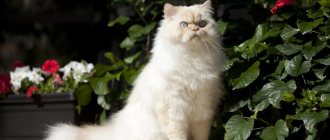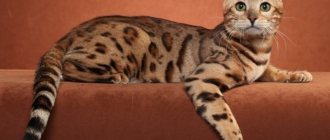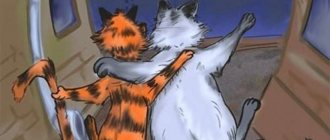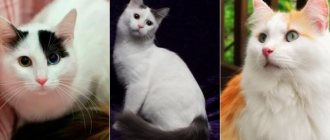Wild ancestors of modern cats
The genotype and phenotype of the domestic cat have evolved over millions of years, so it is impossible to accurately determine its wild ancestor. Many adhere to the version about the origin of cats from creodonts, who lived 50–70 million years ago. This group of extinct animals consisted of predators, scavengers and omnivores. Cats evolved from the first species. The size of these creatures was many times greater than that of lions and tigers. Their victims had virtually no chance of escape, so they caused panic in smaller animals.
Creodont cat ancestor
A branch of miacids separated from the creodonts. They differed from their ancestors in their more developed intelligence, smaller size, elongated plastic bodies, short legs and elongated muzzles, which gave them a resemblance to martens. Miacids were characterized by greater endurance and adaptability to new climatic conditions, but were still less physically developed than modern predators.
Proailurus
Subsequently, miacidae divided into 2 groups, one of which became the ancestor of dogs, the second, proailurus, became the ancestor of civets, the predecessors of cats. The last category of animals had even smaller sizes, greater flexibility and dexterity, which allowed them to live in trees. Subsequently, pseudodelurus evolved from it, from which modern pets and extinct saber-toothed cats originated.
Steppe cat
The closest ancestors of domestic cats are steppe cats, which today live in Africa, Asia, Northern India, Transcaucasia and Kazakhstan. In Russia, these animals can be found in floodplain forests and bushes of the Astrakhan region. Representatives of this breed are somewhat larger than their domesticated counterparts. These animals lead a solitary lifestyle and hunt small animals and rodents.
Cats these days
Now let's turn to the feline species, which has managed to survive to this day, mainly due to qualities that provide it with greater ability to adapt to environmental conditions than other relatives. As a result of long-term evolution, the following descendants of the genus of cats that currently live on earth came from neophelides: these are cheetahs and cats.
Cheetahs are an independent species of this family.
Cats are divided into large and small. The first branch includes modern tigers, jaguars, lions and leopards. Small predators include relatively small predators that differ in both color and size. These are all breeds of domestic cats known to us, as well as lynx, puma and some others.
Very few reliable facts have reached us about the wild ancestors of our beloved cats. Nevertheless, researchers are working in this direction, trying to collect and organize the information obtained into a single picture.
Cat as an attraction
Ekaterina Kachura-Falileeva.
At the samovar. 1st half XX century Cats still “work” in the Hermitage - not in the exhibition halls, but in the courtyards and basements. Each cat has a veterinary passport, a bowl and a basket for sleeping. In 2021, the British publication The Telegraph included the Hermitage cats in the list of unusual attractions that you must see if you come to St. Petersburg.
“There are only 50 cats, I set this limit myself. They live in the yard and in basements. We give “extra” cats to good hands. They know their habitats in the basements; there is no need to guide them. We have interviews and filming about cats no less often than about Rembrandt.”
Director of the Hermitage Mikhail Piotrovsky, Literaturnaya Gazeta, 2014
History of wild cat domestication
It is known that cats were domesticated later than dogs. Until people began farming, there was no need to keep these creatures. When people began to stock up on food, they were faced with the problem of rodents destroying their supplies. Noticing that cats love to hunt small animals, people began to domesticate them. What are the main stages of cat domestication?
Domestication of cats in the Fertile Crescent 9,500 years ago
Based on the latest research into the genotype of the domestic cat, it was first domesticated in the Fertile Crescent about 10,000 years ago - in the area of the Sumerian civilization, in the lands of modern Iraq, Israel, Syria, Lebanon and Jordan. It is not known whether the Sumerians treated representatives of the cat family as sacred creatures, but there is evidence of the participation of these pets in hunting not only rodents, but also small animals such as hares and even snakes.
Then cats from the Fertile Crescent came to Egypt, where they were given special importance. There were 3 types of cats living in this country: steppe, reed and nocturnal Nubian, images of which can most often be seen on the walls of temples and tombs. There is also a version about the parallel domestication of these pets by the Egyptians. It is known for sure that it was from the Nile Valley that these animals came to Ancient Greece and the countries of North Africa.
The appearance of domestic cats in Europe
The appearance of cats in Europe is due solely to pragmatic considerations. During the heyday of the Egyptian state, it was forbidden to take cats outside its borders. As a maritime power, it traded with many countries, and traders, not wanting to suffer losses due to rodents, took cats with them on ships during their travels, from where they ended up on all continents. It is known that already in the 4th century BC. e. these pets inhabited the territory of modern Great Britain.
In Europe, cats were initially highly valued. In the X–XI centuries. The rulers of some European powers even issued decrees on the rules for treating these animals. With the beginning of the Inquisition, they began to be perceived as companions of witches and exterminated.
In Rus', cats have always been treated well, considering them a symbol of wealth and well-being. It is still a popular custom among the Eastern Slavs today to let a cat be the first to enter a new home, so that it will bring happiness and always protect the home from misfortunes.
Is the domestic cat domesticated or does it just live next to humans?
Cats have been accompanying people for many centuries, but there is no consensus on whether they are domesticated animals. Despite their impressive appearance, these creatures have retained their independent character and good adaptability to the conditions of the wild in almost unchanged form. There are 2 points of view regarding the issue of cat domestication:
The only animal in the temple
Ivan Bilibin. Scientist cat. Frontispiece to “The Tale of the Golden Cockerel” by Alexander Pushkin. 1910
In the Catholic countries of medieval Europe, cats were considered minions of witches and servants of the devil - especially black ones - and were burned at the stake. In Orthodox countries, they were treated exactly the opposite. In Rus', a cat was considered a pure animal. Of all the animals, only she was allowed to enter the temple. In addition, cats saved the bins of churches and monasteries from rodents, which provided them with the patronage of priests for many years.
CAT GENES
Carlos Driscoll from the National Cancer Institute (USA) and his colleagues from different countries analyzed the genetic material of 979 representatives of domestic and wild cat species: European, Middle Eastern, Central Asian, South African and Chinese desert cats. They published their findings in the journal Science (text in English, free registration required to read). It turned out that all currently existing wild cat species are subspecies of one common species - Felis Silvestris (Latin: Wild Cat). But the DNA of domestic cats coincided with the DNA of only one of these subspecies - the Middle Eastern wild cats Felis Silvestris Lybica (lat. Libyan Wild Cat), living in the remote deserts of Israel and Saudi Arabia. Moreover, the ancestors of absolutely all domestic cats were no more than five individuals, whose descendants, accompanying humans, settled throughout the world.
Photo: Daniele Colombo CC BY-NC-SA 4.0 Pictured: Felis Silvestris Lybica
Myths, legends and original versions of the origin of cats and their appearance on Earth
Due to their attractive appearance, independent character and special manner of communicating with humans, cats have long been attributed with unusual properties and otherworldly origins.
Many believe that these animals can predict natural disasters and heal their owners. Their ability to group in a jump and almost always land on their paws never ceases to amaze. Where could cats come from?
The Myth of Noah's Ark
Interestingly, according to legend, there were no cats on the ship into which God ordered Noah to take a pair from each type of animal. According to the Old Church Slavonic apocrypha, the devil got into the ark, turning into a mouse, and tried to gnaw its bottom, but after Noah’s prayer, God sent him a cat and a female cat, who killed the pest. According to another version, these animals appeared from the nostrils of a lion when Noah stroked him.
The Divine Origin of Ancient Cats
In Ancient Egypt, cats were attributed to divine origin and, accordingly, were given corresponding significance. The sacred role of representatives of the cat family in ancient Egyptian society is evidenced by numerous frescoes and statues found during excavations. Pharaoh Akhenaten, the husband of the famous Nefertiti, considered himself the son of the sun god, and all cats and cats - his brothers and sisters.
Bastet
It is known that it was customary for the ancient Egyptians to depict the goddess of fertility and hearth, as well as fun and joy, Bastet, in the form of a woman with a cat's head or a cat. In the city of Bubastis, a temple was built in honor of this goddess, and her high priest bore the title of great healer. Bastet, like a cat, sometimes became ferocious and turned into the lioness goddess Sekhmet, who was distinguished by incredible cruelty, but also patronized warriors and healers. It is known about magnificent holidays in honor of Bastet, when pilgrims gathered in Bubastis, where they drank a lot of wine, played musical instruments and sang.
If there was a fire in the house, cats were rescued first as God's messengers, and then the rest of the property. After death, pets were embalmed and buried in richly decorated caskets, but most importantly, mourning was observed. Not to mention killing, the ancient Egyptians were subject to severe punishment and public condemnation for beatings and disrespectful treatment of these animals.
Cats are messengers of extraterrestrial civilization
Ancient Egyptian mythology gave rise to a version about the alien origin of cats. Its adherents believe that a hairless cat flew to Ancient Egypt from another planet, which spoke human language and mentally communicated with people. Having met and fallen in love with a wild steppe cat in the forest, she decided to stay on this planet and acquired offspring from her beloved, from whom all domestic cats subsequently descended. Interestingly, astronauts collected small coin-like formations on the Moon. It turned out that their composition is similar to cat feces.
The latest funny stories about cats
"Bad luck"
In the evening after a hard day I decided to relax in front of the TV. I made tea, turned on the movie, and didn’t bother anyone. My cat sat down on the floor in the hallway, listening to all the rustles in the front door. She growled menacingly at everyone who passed by our apartment, that’s how militant she is. Soon I got tired of these tricks of hers, I shouted at her a little. This helped, nothing else distracted me from watching TV, at least for the next five minutes, after which I heard a terrible cat scream.
I look around, my purr is nowhere to be found, I went into the corridor - it’s not there either, I run into the kitchen - and there the cat is hanging head down with its tail wrapped around the radiator. I just recently painted this battery. The tail stuck, interestingly enough, tightly, so I was forced to cut off the fur. But the battery turned out to be fluffy and white.
"Generous soul"
I once lived with a cat, Manya, the most common “yard” breed, but her intelligence and stubbornness could not help but amaze. Her favorite pastime was stealing. My mustachioed darling stole all sorts of goodies, she stole not at home, but from neighbors, and, what’s important, she took everything she stole into the house. One late evening I tried to fall asleep for a long time, and when it seemed that sleep had finally come to me, I felt something cold and large next to my head.
I grabbed this “something” with my hand, it was soft to the touch, a little viscous, very unpleasant, so I reflexively threw this “thing” aside. I jumped out of bed, turned on the light, looked at the floor, and there was a piece of meat, gnawed, all in a torn plastic bag. I look at the bed, and there my Manka is sitting and looking at me with such a gentle look, saying, “Eat, this is for you.”
"Reined in"
A bachelor friend of mine lived with a cat named Gray. One day he decided to have another “living creature” in the apartment and bought a parrot. Not only he, but also the purr liked this acquisition. The homemade pussy felt all her hunting instincts awaken within her. The parrot had a hard time; he couldn’t let down his guard because of the risk of being caught.
Gray made him look for the fifth corner every 5-10 minutes. Such “games” continued for months. During all this time, the cat never managed to catch the parrot. Either she wanted it that way, or the bird turned out to be clever. Whatever it was, the latter soon got tired of the “hunt”. Having somehow noticed how a furry tormentor was approaching him, the parrot, instead of flying into the air, turned around and said: “Gray, get out.”
With these words, the owner usually drove away his pet when it got under his feet. Gray did not expect this from the bird; the cat looked at her prey in shock, and then slowly sank down, bending her paws. After that, she completely lost interest in the parrot.
To protect barns and deter mice
Vyacheslav Schwartz.
Scene from the home life of the Russian Tsars (Chess game). 1865. State Russian Museum The son of Alexei Mikhailovich Peter I considered cats to be animals that could be useful. In one of the decrees, he ordered “to have cats in the barns, to protect them, and to intimidate mice and rats.” Peter I's favorite cat was named Vasily. The Tsar took it in 1724 from the house of a Dutch merchant who traded in Vologda - Peter the Great often visited him.
Abyssinian cat
Of all the ancient breeds, the Abyssinian probably has the most confusing and controversial origins. Some believe the breed's origins go back to ancient Egypt, as it resembles many artifacts from that time. Of course, the modern Abyssinian cat is very different from its ancestor. The now famous breed was developed using Burmese, Russian Blue and Siamese cats.
Russian and cat are brothers forever!
With the growing popularity of cats, various signs, sayings and proverbs related to cats began to appear. Cats have firmly entered folk tales, perhaps displacing more ancient characters and taking over their functions. The cat's nature made quite a strong impression on the Russians, and cats began to be credited with various magical abilities.
The gloomy and mysterious Cat Bayun is a unique character in Russian fairy tales.
By around the 16th century, almost every family in the Russian Empire already had a domestic cat. The words “cat” and “cat” even appear in historical documents, and not only as independent words, but also in the names of influential people, for example, boyar Fyodor Andreevich Koshka-Kobylin. Also quite often, “cat” is found in the nicknames of ordinary people. For example, in the writs of 1545, a Novgorod peasant named Konstantin the Mouser Cat was noted.
Siberian cat
This breed is also known as the Siberian forest cat. The breed has a long history and originates in Russia. It is believed that the Siberian is also the ancestor of all modern long-haired cats. The Siberian forest cat is probably closely related to the Norwegian forest cat. This cat was one of 3 longhaired breeds that were described during the first cat show in England in the 1700s.
Cats in Rus'
8 main facts
Today it is absolutely impossible to imagine our life without cats. Some people keep them at home, like our editor-in-chief, for example, while others, like the author of this text, have severe allergies to them and therefore prefer to admire cats from a distance. But even if you start crying and sniffling after just five minutes of communicating with a furry creature, you still love and admire it. It seems that there have always been cats. Or is it not? How, for example, did things stand in medieval Rus'?
When we started looking for information, it turned out that there is not a single large specialized study about ancient Russian cats, and most of what can be found on the Internet are reprints of one (very good) article written about 30 years ago. To this material, the authors, to the best of their imagination, add vivid details, which, however, are usually not confirmed by anything. We firmly decided to figure it out and, separating the wheat from the chaff, collected 8 main facts about the life of seals in Rus'.
Fact No. 1: In Ancient Rus', seals were introduced in the 9th-10th centuries.
The question of when cats were first introduced in Ancient Rus' can be answered by archeology. On the territory of the Rurik settlement, three kilometers from the center of Veliky Novgorod, scientists discovered fragments of the skeletons of six cats in the layers of the 9th-10th centuries. Cats were probably not yet widespread at that time (compare the number of cat bones with the number of dog bones according to the table). Thanks to the finds of archaeologists, we can confidently say that cats definitely lived in the houses of the Russians (and both representatives of the elite lived at the Rurik settlement - the prince and his squad, as well as service personnel) already during the formation of the Old Russian state - that is, during the times of the Prophetic Oleg, Olga and Svyatoslav. As for the keeping of these animals by peasants, we are forced to shrug our shoulders - no traces of the life of cats in the villages have yet been found. However, it must be noted that rural settlements in Eastern Europe have been studied quite poorly, and new discoveries may still await us.
Animal bones found at the Rurik settlement. Images from the article by M. V. Sablin “Fauna of the Rurik settlement (based on the results of excavations in 2000–2011)” // Nosov E. N., Plokhov A. V., Khvoshchinskaya N. V. Rurik settlement. New stages of research. St. Petersburg, 2021.
Fact No. 2: the first mention of seals in the chronicles is related to the fact that they were... eaten.
Sadly, seals are most often mentioned in written sources as food. Of course, in ordinary life they were not eaten - this happened only in an emergency: during famine. The Novgorod First Chronicle describes the terrible events of 1230 as follows: “and the troupe was circumcised by Judahou. and drowsii koninou, psinou. cats. nb those osochishche tako tvoryahou” (NPL, 113 vol.).
The fact that the townspeople started eating cats shows that they had no other food left. This terrible mention (probably the oldest in written sources) dates back to the middle of the 13th century, when the text of the chronicle was written. In general, cat meat was considered unclean, and eating it, according to medieval scribes, was a sign of savagery. Thus, in the Laurentian Chronicle one can find the following description of the wicked tribe: “I eat every kind of filth. mosquitoes and flies. kotki (this form of the word was used on a par with the familiar “cat.” – Ed.), serpent. and a dead man is not a cellar” (LL 1377, 85 a (1096)).
Fact No. 3: cats in Rus' lived in cities and were smaller than their modern counterparts.
The cats of Ancient Rus' were city dwellers. The remains of their bones were found by archaeologists in Kyiv, Old Ryazan, Novgorod, Tver, Yaroslavl, Smolensk[1] and other cities. Researchers believe that these were rather small animals: the average height at the withers did not exceed 30 cm, and ancient Russian cats weighed no more than 4 kg[2]. Although there were exceptions: at the Trinity excavation site in Novgorod, the heel bone of a real giant was found. Its size is larger than average not only for a domestic cat, but also for a wild one. One can only guess where the giant cat came from in the city. Perhaps this is still a wild cat, caught by Novgorodians while hunting, perhaps a domestic cat, donated or brought by foreign merchants.
There is also no clarity about what breeds of cats lived in Ancient Rus'. Firstly, according to researchers, it cannot be argued that in the Middle Ages anyone was specifically involved in the selection and breeding of these animals[3]. Secondly, based on osteological, i.e., bone material (and only this is preserved), it is impossible to judge such important characteristics of the breed as the color and density of fur, temperament, and the ability to catch mice, finally. Most likely, seals in medieval Russian cities lived almost independently and obtained their own food. And no delicacies from your kind owner or periodic trips to the veterinarian. Cat life was filled with hunger and danger - many animals died (or were killed) at a young age. Judging by the marks on the bones, some cats were skinned after death[4] - even a dead animal could be used on the farm. It turns out that the owners were pragmatic about their pets and did not care about them too much. The more surprising is the following fact.
Fact No. 4: in the 14th century, seals were valued several times more expensive than cows and on a par with dogs.
The so-called “Metropolitan Justice”, a legal monument of the 14th-15th centuries, lists the following fines for theft:
“...for a cat 3 hryvnia, for a dog 3 hryvnia, for a mare 60 kun, for an ox 3 hryvnia, for a cow 40 kun, for a third 30 kun, for a hollow half a hryvnia, for a calf 5 kun, for a boran nogata, for a pig nogot, for for a sheep 5 kun, for a stallion hryvnia, for a foal 6 nails”[5].
If we consider a kuna equal to 1/50 of a hryvnia [6], then 3 hryvnia = 150 kuna, which is almost 4 times more than what was demanded for a cow. Even if we take the earlier “rate” of the 11th century - 3 hryvnia = 75 kunas, then this amount is almost 2 times more than the fine for a cow. Surprisingly, the cat was valued as highly as the dog and ox, which were much more closely involved in the human economy. Such a fine looks even more strange if we take into account our assumption that cats survived in ancient Russian cities on their own and were “yard servants”. Maybe the church representatives had some special purebred cats living with them? The source says nothing about this.
Fact No. 5: cats did not save Rus' from the plague.
Contrary to popular belief, which can often be found now on the Internet, the plague epidemic in Rus', where cats were supposedly welcomed, was no less rampant than in Western Europe, where the cat was indeed sometimes considered a companion of the devil and witches. Completing its “tour” across Europe, the great epidemic of the 14th century swept through Rus' in 1352. In 1353, the Grand Duke of Moscow Simeon Ioannovich the Proud and his two young sons died. The population of Moscow decreased significantly, the Pskovites did not have time to bury the dead, and in Glukhov, according to the chronicler[7], no one survived at all. Alas, neither cats nor all the medical practice of the Middle Ages provided any protection from the pandemic that overtook the world.
Fact No. 6: a cat is not always a cozy pet; sometimes it can be very dangerous.
In the “Solikamsk Chronicler” you can find a story about a strange incident that happened in the Verkhtagil fort (a settlement on the Tagil River in the modern Sverdlovsk region) at the end of the 16th century:
“And the governor in it was Ryuma Yazykov from Moscow. And the governor brought with him a larger Kazan cat. And still he kept Ryuma close to him. And that cat went down the throat of the sleeping man and ate him to death in that town...”[8]
So what happened to the unfortunate Ryuma Yazykov? How big did a Kazan cat have to be to gnaw a person's throat? Let’s not forget that Ryuma managed to serve in the Streltsy troops before his appointment, and, without a doubt, knew how to fight very well. According to one version[9], the reed cat, a large predatory animal whose weight can reach 12 kilograms, is called the “Kazan cat” in the chronicles. Jungle cats live in the lower reaches of the Volga, where one of them could theoretically be caught and sold to an unlucky governor. What provoked the cat’s attack on a person - lack of food, poor treatment, or simply the wild nature of a not fully domesticated animal - we can only guess.
According to another version, a representative of a special breed of domestic cats, the Kazan mousecatchers, is to blame for Ryuma’s death. The breed has not survived to this day. According to some reports, these were large animals with a round head, a wide muzzle, a strong neck and a short tail. Kazan cats are well known in connection with the activities of “Peter’s daughter” Empress Elizabeth, who issued the famous decree on sending cats to the court to fight the mice that had proliferated in the Winter Palace. This is how the tradition that still exists today arose of keeping cats in the Hermitage to protect works of art. The story is yet to come about what role Kazan cats played in Russian folklore of the 17th-18th centuries.
Fact No. 7: the first Russian cat, whose image we have preserved, lived in a palace.
“Authentic portrait of a cat of the Grand Duke of Muscovy” is the name of a print by the Czech artist Wenceslas Hollar, dated 1663. After checking the chronology, we can conclude that this is the cat of Alexei Mikhailovich “The Quietest,” father of Peter I. This tsar was generally very fond of animals and game birds, which he kept in large numbers in his country residence Izmailovo. Hollar's engraving is now kept in the National Library of France. Unfortunately, we know almost nothing about the circumstances of its creation. It has been suggested that the image was made by an artist who accompanied the Austrian Baron Augustine Meyerberg during his trip to Russia, and also that Tsar Alexei Mikhailovich himself is depicted as a cat in the print, but these hypotheses are not confirmed.
Fact No. 8: the cat is the main character of the most popular folk picture.
In point No. 6 we already talked about Kazan cats. Let us now look at them not as skilled mousecatchers and dangerous killers, but as heroes of Russian (and not only) folklore. Historian Sait Fyarizovich Faizov believes that the prototype of the legend about the Kazan cat arose in the middle of the 16th century:
“...closest to the hero of the popular print is the Cat of the Kazan Tsar (Khan) from the Mari legend “How the Mari went over to the side of Moscow,” which tells about the siege of the Kazan Kremlin in 1552 by the troops of Tsar Ivan the Terrible. The court cat from this legend managed to overhear how the Mari kings Yylanda and Akpars, besieging the fortress, were digging under the Kremlin wall, and he warned the khan about the danger. Khan, his wife, daughter and cat went through a secret passage to the Kazanka River, got into a boat and safely sailed away from Kazan”[10].
In the second half of the 17th century, lubok appeared in folk culture - painted pictures on wood and metal. One of the most popular popular prints is the funeral of a cat by mice. And on the firewood, in the center of the funeral procession consisting of mice, is not just a cat, but precisely “Kazan cat, Astrakhan mind, Siberian mind...” What does all this mean? Many researchers believe that both the mice and the cat in the picture actually represent someone who cannot be directly named. A popular version claims that the cat being buried by mice is Tsar Peter I, and the authorship of the picture is attributed to the Old Believers, some of whom declared the emperor the Antichrist. S. F. Faizov considers the Cat of Kazan to be a unique image of the Tatars in Russian culture, which arose after the conquest of their three kingdoms (Kazan, Astrakhan and Siberian) by Ivan the Terrible. During the 18th century, the plot of the Cat’s funeral changed, acquiring an increasingly anti-government overtones (for example, the mice on the popular print began to represent various regions of the Russian Empire, many of them had “grievances” against the cat, etc.).
If we try to find out the original meaning of the plot about the funeral of a cat by mice, then its political background should still be relegated to the background. As M. A. Alekseeva notes, in folklore real life events are rarely conveyed directly. The humor in the popular print about the Kazan Cat is not accusatory. This is not “evil” laughter at the authorities, but, in the words of the great cultural critic Mikhail Bakhtin, “buffoonery,” “laughter in the world, where everyone laughs at everyone, including the “laugh-makers” themselves.”[11] Thus, humor, political conflicts and a love for cats, which has not left us to this day, are mixed in the popular consciousness.
[1]Archaeology of ancient Yaroslavl. Riddles and discoveries. 2nd ed. M., 2012. P.214-229.
[2] Zinoviev A.V. Cats of medieval Novgorod the Great and Tver // Archeology and history of Pskov and the Pskov land. Seminar named after Academician V.V. Sedov: Materials of the 63rd meeting. M., 2021. pp. 183-197.
[3]Ibid.
[4]Ibid.
[5] Monuments of Russian law. M.: Gosyurizdat, 1955. Issue. 3: Monuments of law from the period of formation of the Russian centralized state in the 14th–15th centuries. / ed. L. V. Cherepnina.
[6]Numismatic dictionary. 4th edition. Zvarich V.V. Lvov, 1980.
[7] Complete collection of Russian chronicles. T. 10. VIII. A chronicle collection called the Patriarch's or Nikon's Chronicle. / Ed. A. F. Bychkova. – St. Petersburg, 1885. P. 224.
[8] Siberian chronicle code: Note book // Complete collection of Russian chronicles / ed. A. P. Okladnikova, B. A. Rybakova. T. 36: Siberian Chronicles; Part 1: Group of the Esipov Chronicle / preface. N. N. Pokrovsky, E. K. Romodanovskaya. M. 1987. P. 141.
[9] Shashkov, A. T. On the history of the emergence at the end of the 16th century. the first Russian cities and forts on the eastern slopes of the Urals // Ural collection: History. Culture. Religion. Ekaterinburg, 1997.S. 176.
[10] Faizov, S. F. Cat of Kazan: Tatar and Tsar in the perception of the Russian after the “capture” of the Kazan, Astrakhan and Siberian Khanates. https://www.idmedina.ru/books/materials/faizhanov/5/hist_faizov.htm?
[11] Alekseeva, M. A. Wood engraving “Mice dragging a cat to a churchyard” is a monument of Russian folk art of the late 17th - early 18th centuries. // XVIII century collection. : Russian literature of the 18th - early 19th centuries. in the socio-cultural context. T. 14. L., 1983. P. 45-79
Funny stories about cats and cats from real life
"I did not notice"
My cat Vasilisa loves to go “for a walk” on the balcony, which, of course, is often closed. In such cases, Vasya has to call someone for help, meow and attract the attention of the owners so that they let her out. My friend decided to make our life a little easier and taught the cat to go out onto the balcony through the window. She really liked this “travel” method, she began to use it regularly, and everyone felt good about it.
One day, we were talking with a guy in the kitchen, we heard a crash, as if someone had crashed their head into the glass, and then a grinding sound, as if someone was sliding down the window. We run into the room, and there our Vasya is sitting, dumbfounded... we look - the window is closed.
"Far from being injured"
In the evening I’m busy in the kitchen; my husband has returned from fishing and is cleaning the fish he caught with his own hands. A cat is spinning at his feet, emitting heart-rending screams, that’s how she begs. I soon got tired of her meowing, I told my husband: “Cut off the cat’s head!”, meaning, naturally, a fish head for the cat. After this, there is a crunch of the cervical vertebrae, followed by a loud “MEOW”, and then a slap on the floor and silence.
Hearing all this, the child shouted “Papaaaa” and ran into the kitchen with his eyes wide open in fear. The child imagined the worst thing, and looked - the cat was alive and healthy, happy, enjoying her share. My husband and I laughed for a long time after that.
"These are cats"
My mother moved to the village. She is a dog lover and doesn’t like cats, but she can’t do without one in the yard; someone needs to catch mice. I came to visit her one day and saw that there were at least a dozen mustachioed and striped ones wandering near the house. Mom buys milk for them from a neighbor, pours it into a basin and crumbles bread there. I look at this picture, at the happy, fluffy faces, and say:
- Mom, why do you fall in love with cats? You have a lot of them here...
“My cat is that red one,” he points. – The rest just come to “earn extra money” and take turns carrying mice.
Pause. Sighing heavily, my mother added:
- It is possible, of course, that they are carrying the same mouse. These are cats, after all!
“Psychologist for a cat?”
My brother and his wife moved to Hong Kong, and two cats live in their apartment. They learned from local friends that in the city you can use the services of a psychologist for cats. Like, it will help if the pet started to behave strangely or its behavior simply became problematic.
My relatives remembered this service when one of the cats annoyed them with its presence in the bedroom. The door is closed - and she sits in front of it and yells. Nothing helped stop her from doing this. They turned to that same miracle specialist. He advised them to scare the cat in the bedroom so that it would be afraid to go there in the future.
Every day they sat in a room with pots and banged on them with metal scoops. It had no effect on the cat. She probably thought that her owners needed a psychologist, or even a psychiatrist.
"Satan"
One day we got together with friends at my house, there was nothing to do, we surfed the Internet and found an article about how to summon the devil. Of course, nothing worked out, though. A couple of days later, a cat came into my apartment. At first I thought that it would be great to live with him, I was even afraid that he and the dog wouldn’t get along. How wrong I was. On the very first day, the dog was hiding in horror from this fiend under the bed, and I was hiding at home from people because my whole face was scarred from the claws of this devil.
I decided to take him to the vet to get the necessary vaccinations, but the cat thought differently - he tore the doctor’s clothes, and at home he gave me “punishment” by breaking a couple of jars of jam and scattering all my clothes around the room. I gave this cat the name Satan because I realized that we did call the devil that night, only he was a little busy then.
"Who did it?"
Our cat has an irresistible love for bags; he loves to crush and fiddle with them. Everything would be fine, but he does it at night, when everyone is trying to sleep. Recently we were at the market and bought ourselves a three-liter jar of honey, which we put in a bag to make it easier to carry. So, our cat decided to play with this particular bag, and at some point he apparently stuck his head into the handle of the bag and hit the sofa.
Of course, he scared himself terribly and ran to escape from an unknown misfortune, and with such force that he tore the bag halfway from the kitchen to the room. The sounds from this, of course, were not exactly quiet, so a minute later the whole family was standing next to a jar lying on its side and a bag without a handle, which was on the cat sitting next to it. He looked at it all with inexpressible surprise, as if he, too, was trying to sleep and was now asking: “Who did this?”
"Search Cats"
My husband smokes, I really don’t like it, but I can’t convince him. We constantly quarrel with him because of this, it got to the point that I threw cigarettes in the trash, in the toilet, or just on the street. This really infuriated my husband and he swore. I love him very much, so I decided to wean him off smoking more gently.
This idea came to me when I read about dogs in the army and police. There was an article about how they are taught to detect drugs by smell. I thought, cigarettes are also a drug, and cats also have a good sense of smell. Do you get the idea? Yes, I trained cats to eat cigarettes, and now they find them everywhere and chew them. It’s impossible to smoke them after this, I pretend to be surprised by the cats’ behavior, and everything turns into a joke.
"Happy cat"
There are few windows in my apartment. It's almost summer now, and my heating is centralized, so the radiators don't work. It turns out that they now cool the whole house, and since there are only one or two windows, it’s colder in our apartment than outside. To keep the cat warm while I'm at work, I wrap him in a blanket.
At first I was afraid that he would crawl out of it and freeze in the end, but it turned out that the cat does not at all want to leave the heated place. I don’t know whether he learned to wrap himself up again or not, but when I arrive, I see the cat in the same place with inexpressible happiness in his eyes.
"Lizard"
My cat turned into a lizard. I'll explain everything now. It was a child’s birthday, so that everything went as expected, they hung balloons on the chandelier. And not two or three, but just a big cloud. Balls have three states. Everyone knows this: when they are inflated and tend to the sky, deflated, we buy them in this state, and the balloon doesn’t seem to have deflated yet, but I realized that it won’t reach the Sun and is now hanging there, gloomy and sad, living out its week .
We have just entered this stage. The strings of the balls were long, so now they are almost lying on the floor. Apparently, these were unusual balls, but an ancient Egyptian artifact that turns all cats into snakes and lizards. How else can we explain that the cat now moves only at the speed of an airplane and exclusively by crawling?
"Offended Cats"
I love cats, so I have three of them, and they are all twins. They shed at the same time, in the spring, so I think it’s not worth telling you what’s happening in the apartment at this time. It feels as if some evil, despicable brownie is shaving them at night, by the morning new hair grows, but the old ones are scattered in all corners. The vacuum cleaner is already clogged, and the broom is covered in wool. I decided to shave them.
And since March and April were not very warm, I waited until May so that the cats would not freeze without fur. And now, finally, the first thaw, 25 degrees has remained for two days, and I sit down to shave them. We talked for a long time about the need for this procedure. We agreed that in the summer the wool would not accumulate excess heat, and it would be less cool. And what do you think? The warm days are over and the rains have begun. There is no heating, the apartment is cold, the cats are still freezing. And now they walk and look at me offended, and they are also deliberately shivering from the cold. It really breaks my heart...
"Cucumbers"
My mother-in-law lives in the village, she has a vegetable garden there, we periodically come to her to grow potatoes, and just to help. Once again, she asked us to help with the cat. I ask, what's wrong? He seems to be sitting quietly by the stove, generally sleeping. While we were working outside, I never saw him.
It turned out that they and their neighbors were experiencing the First World War in miniature. The mother-in-law's plot and the neighboring one were at enmity. She herself did not want this war, but the army did not ask her. More precisely, not an army, but an ill-fated cat. He wanted to recapture territory from his neighbors so much that he began to carry out sabotage on them. He stole cucumbers from the plot. Yes, we were shocked too, but the cat really stole cucumbers and then ate them.
"Nightmare"
I never had cats as a child, but recently my parents got themselves Murka, a black cat. I would call it not Murka, but “The Nightmare of All Russia.” I'm 25 years old, I don't seem to be a cowardly guy, but this... It scares me. We live with our parents in different cities, and recently I came to visit them for a week. So that you understand how capricious this one is, I’ll tell you about my usual night hike. I am a night owl, that is, a person who gets up and goes to bed late. Usually, when everyone goes to bed, I sit on the Internet and just relax.
And somewhere, at one in the morning, I go to the kitchen, drink water, and then sleep. On the very first day, the cat drove me into a trap. I drank water and was about to sleep, but Murka thought otherwise. She stood up at the exit and began to hiss. Yes, deep down I understood that it was unlikely that she would kill me now with a lightning-fast jump, but I didn’t want to face the wrath of this creature. Standard methods, such as using a towel, waving your hand, or screaming, did not help. I admit, a twenty-five-year-old guy had to call his mother to save him from an evil cat.
Cats in the service of the Empress
In conclusion, it would not be superfluous to recall another interesting fact related to the Russian history of cats. A decree of the Russian Empress Elizaveta Petrovna dated October 13, 1745 orders that the Kazan governor deliver to the then Russian capital eighty of the best cats and cats, as well as a person who would care for them. Such a strange decree had a very simple reason - the imperial palace suffered greatly from mice. After some time, popular rumor embellished this fact with a mass of semi-fairy-tale details. As a result, they began to talk about three hundred cats who were supposed to serve in the palace.
Since the time of Elizabeth Petrovna, cats have become an integral part of St. Petersburg palace life.
True, it remains unknown why this mission was entrusted specifically to the Kazan governor, but this does not change the fact. Perhaps there were many cats in this province or they were distinguished by some outstanding qualities. The latter is supported by the fact that a popular print with the title “Kazan Cat” has survived, indirectly indicating the popularity of Kazan cats among the widest segments of the Russian population.
If you find an error, please select a piece of text and press Ctrl+Enter.
Persian cat
Like the Angora, the Persian cat has long hair. And since the Angora is considered the first cat to have long hair, this means that the Persian is not as ancient as the Angora. However, again, this causes a lot of controversy, and there is no clear opinion on this matter.
The Persian cat originated in Persia, which is today known as Iran. Long-haired cats were first described in Europe in the 1400s, but exactly what breed they were is not known. It is very likely that these European longhaired cats are the ancestors of modern Persian cats.
Cats are a luxury
Initially, cats were very expensive, there were few of them, and there was a huge fine for their theft. The church helped to breed cats; cats were settled in monasteries, in rich houses and in royal palaces. Naturally, at first few people could afford to keep these rare (still) animals; it was simply beyond the means of the majority of the population.
Then, over time, there were more and more cats. And tailed rodent destroyers began to be found in many houses, and even in village huts.











